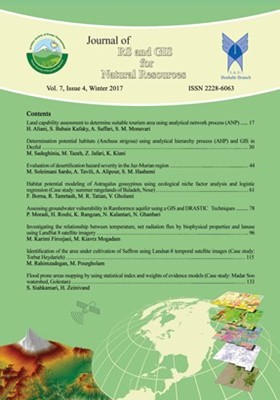Determination potential habitats (Anchusa strigosa) using analytical hierarchy process (AHP) and GIS in Dezful
Subject Areas : Geospatial systems developmentMajid Sadeghinia 1 , Mehdi Tazeh 2 , Zahra Jafari 3 , Koroush Kiani 4
1 - Assis. Prof. College of Agricultural Sciences and Natural Resources, Ardakan University
2 - Assis. Prof. College of Agricultural Sciences and Natural Resources, Ardakan University
3 - MSc. Student of Rangeland Management, Ardakan University
4 - MSc. of Forestry, Khouzestan Province Forests, Range & Watershed Management Organization
Keywords: Analytical Hierarchy Process (AHP), Dezful, habitats map, Anchusa strigosa, Geographic Information System (GIS),
Abstract :
Native plant development is one of the ways to restore degraded rangelands. In Dezful, Anchusa strigosa is a medication species which is one of the region’s main exports. Due to habitat degradation of this species by overgrazing and rangeland degradation, by considering ecological demands, its habitat can be developed. The aim of this study was to determine the potential sites for development, according to the criteria of Anchusa strigosa climate, soil and topography using geographic information systems and hierarchical analysis. For this purpose, In 2015, the spatial data for species presence was used as potential locations for growth. Part of the habitat of this species was extracted from studies using ground and the points which were grabbed. The first point map of the field was prepared by visiting the areas and habitats, and then current biophysical information was extracted. For completing the information, from other sources, the ecological demand of species was extracted and combined with ground-based data. The six criteria map were prepared, classified and standardized in ArcGIS®10.1. As the weight of the layers is not identical, to prioritize the areas of potential habitat, analytical hierarchy process (AHP) was used to weight the criteria. The results showed that of total area 464547.3 ha, 31% accounts for good habitat, 38%, average habitat and 7% poor to very poor habitat. The results also showed that the significant dip weight and the minimum weight is most significant measure that shows no inclination and most valuable to the growth of this species. The results can be used to modify the operation of the ranch and mapping of suitable areas for development use.
_||_


